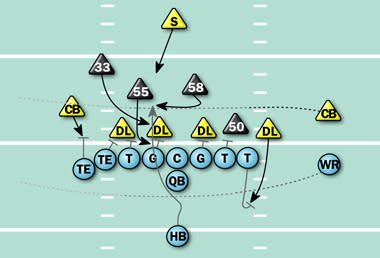Colts need pressure to plug run holes
Also in this article:
Next Surveillance:
Saints
More NFL:
Editor's note: Yahoo! Sports has examined the biggest weakness of the 2009 season for every team and explain how the franchise can address the issue. The series continues with the Colts, who finished first in the AFC South (14-2).
Biggest problem in 2009: A still-struggling run defense

Stopping the run must be a priority for Mathis (left) and the Colts.
(Andy Lyons/Getty Images)
In many ways, the Indianapolis Colts are the Team that Time Forgot. Each year, they take their future Hall-of-Fame quarterback (who just might be the best ever at his position), match him with interchangeable receivers and a questionable offensive line, pair that with a defense that springs holes against the run, and then roll off anywhere from 12 to 14 wins. A Super Bowl win is always a possibility, and so is a playoff collapse. What does not seem to be an option as long as Peyton Manning(notes) draws breath is mediocrity. Every year they run more three-wide, single-back formations than any other NFL team; every year they split Dallas Clark(notes) out wider more often; and every year the play-to-play adjustments are spit out of Manning's head as if by computer.

Coyer
On defense, however, things have changed a bit under coordinator Larry Coyer, who took over before the 2009 season. Former head coach Tony Dungy generally preferred to have pass pressure and run defense start with the front four, and the Colts under Dungy were known to be one of the more blitz-resistant teams in the league. Indy still relies primarily on the speed of its linebackers to make plays against the run, but things are more reasonable than they were in, say, 2006, when the franchise won its first Super Bowl since 1970 despite having the NFL's worst run defense. With Dwight Freeney(notes) and Robert Mathis(notes) careening off each edge, and generally lighter tackles holding the point in the middle, past Colts defenses were far too vulnerable to the power game.
Coyer's solution was to implement different formations. In 2009, the Colts rushed three just 2.7 percent of the time (down from 5.3 percent in 2008), rushed four 73.4 percent (down from a league-leading 84.8 percent in 2008), rushed five 19.9 percent (way up from a league-low 7.8 percent in 2008) and brought six or more four percent of the time, twice as often as their league-low total of 2.1 percent the previous season. It was a smart move – in 2009, the Colts had a Defensive DVOA Football Outsiders' per-play efficiency metric of 13.3 percent, which was about league average. The Colts rushed four 458 times; only the Titans rushed four more often. But when the Colts upped that number to five, the difference was enormous. With just five rushers, the Colts had a defensive DVOA of minus-17.7 percent, third-best in the league. Expand that to six or more, however, and the swing goes the other way – a 17.7 defensive DVOA, a worst-case scenario. Clearly, the Colts benefit from an extra presence in the middle, as long as they don't sell out to the blitz too often.
The 2010 solution: Expand extra pressure to the run game

Brackett
Moving those pressure concepts to run defense is a potentially crucial decision for the team. With fast linebackers like Gary Brackett(notes) and Clint Session(notes), the preference has been to get guys flying around, but it's also good to have extra men guarding the gaps. In 2009, the defense allowed almost five yards per run play, and was able to stop positive gains on the ground just 16 percent of the time (the league average was 19 percent). One way to stop enemy running backs from tearing off huge gains and still stay true to the Cover 2/Tampa 2 ideal is to occupy the gaps just outside the ends in a straight 4-3 front. The Bears do this a lot, and it allows the kind of pass-run flexibility needed by a defense facing teams that are usually playing catch-up. One example of this happened in Indy's Week 15 win over the Jaguars.

With 9:24 left in the first quarter, the Jags had the ball with second-and-4 at the Indianapolis 25, ready to run the 11th play of their opening drive. They lined up in an extreme power formation, with an extra tackle to the right and two tight ends to the left. Strong-side linebacker Philip Wheeler(notes) (50) filled the right-side "C" gap as weak-side linebacker Session (55) had done on the other side two plays before on a 7-yard run. Pre-snap, cornerback Jacob Lacey(notes) motioned across the formation to match the movement of Jags receiver Nate Hughes(notes). At the snap, Session banged inside and was washed away by slide protection, and safety Melvin Bullitt(notes) (33) was the next line of defense. Given the handoff from quarterback David Garrard(notes), halfback Maurice Jones-Drew(notes) took a step to the right before cutting back and heading into the fray. He bounced off Bullitt just before middle linebacker Brackett (58) was able to bring him down after a 3-yard gain. On the next play, Garrard was sacked, and the Jags had to kick a field goal.
The Colts will never have a powerhouse defense without retooling their entire roster on that side of the ball – they're a speed team through and through. However, the addition of Coyer to the coaching staff has unwrapped a few new schemes, especially in the front seven, and it will be interesting to see what the defense does this year.
